ch 5 - voltage gated Potassium Channels
1/140
Earn XP
Description and Tags
left off on slide 25
Name | Mastery | Learn | Test | Matching | Spaced |
|---|
No study sessions yet.
141 Terms
what are the major functions of K+ channels?
contributing to resting membrane potential, keep action potentials short, terminate periods of intense activity
K+ channels enhance excitability when
closed
how many alpha subunits for 1 functional K+ channel?
4
what subunit targets the channel to the membrane?
beta
Kv alpha subunits open by
changing voltage
KCa alpha subunits open by
voltage AND Ca2+ binding to C terminal
cNG alpha subunit (gated by..)
gated by cyclic nucleotides
Kir alpha subunit only has which transmembrane segments?
5 and 6
Kir alpha subunit
no voltage sensor, so stays open (these are K leak channels)
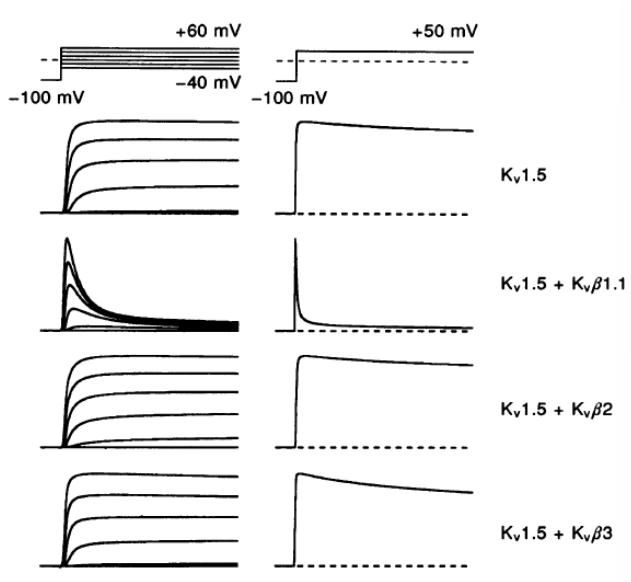
explain the graph
at +50mV, a K channel with just the alpha subunit Kv1.5 opens and stays open. each of the next graphs shows the current with alpha subunit Kv1.5 + a different beta subunit. only the addition of Kv(beta)1.1 results in a fast inactivation.
therefore: presence of beta-1.1 dramatically speeds up inactivation of the channels
Presence of what subunit dramatically speeds up inactivation of the channels?
β1.1
what is the K-channel signature sequence in the selectivity filter?
GYG = glycine tyrosine glycine
are ion channels only within the membrane?
no, sections of channels are present outside the membrane
voltage sensor segment
4
describe how voltage based gating occurs.
change in voltage activates S4, which pulls on the S4-S5 linker, which moves S5, opening the channel.
how are K+ molecules hydrated/dehydrated as they pass through K+ channels?
K+ ions are partially dehydrated before entering the pore, then are fully dehydrated while in the pore. Then they are rehydrated once they are past the pore.
why are Na+ ions unable to pass through K+ channels?
they are not stable without a water molecule, so they would not be able to be dehydrated while passing through the channel. Also, carbonyl oxygens cant do the same dehydration process they do for K+ for Na+.
how are K+ ions dehydrated in the pore?
carbonyl oxygens on the inside of the pore are able to strip off the water molecules from the K+.
what is another name for fast delayed rectifier channels?
Kv
Kv channels open ___ and are shut by inactivation at ___ potentials
open quickly; shut by inactivation at depolarized membrane potentials
as the membrane voltage begins to drop, Kv channels
recover from inactivation and carry current
what is another name for slow delayed rectifier channels?
KCNQ, eag/erg
KNCQ channels open ___ and are mostly ___ at the end of the AP
open slowly, mostly activated at the end of AP
IKs and IKr are subtypes of what K+ channel type?
KCNQ (which are a delayed rectifier type)
describe the difference between IKs and IKr channels
They are both slow delayed rectifier channels, but IKs have slow activation and IKr have rapid activation
KCNQ are ___ at rest
open
when ACh sensitive KCNQ channels are shut down, the cell becomes ___
hyperexcitable
what is the main purpose of KCNQ channels?
keeping excitability in check (by opening slowly and preventing a hyperexcitable M current)
which Kv channels are LVA?
Kv1, Kv4, Kv7
which Kv channels are HVA?
Kv3, Kv2
Out of the LVA Kv channels, which have fast kinetics? which have slow?
fast kinetics: Kv1, Kv4
slow kinetics: Kv7
Out of the HVA Kv channels, which have fast kinetics? which have slow?
fast kinetics: Kv3
slow kinetics: Kv2
what happens when LVA K+ channels are blocked?
another action potential occurs quickly after the first
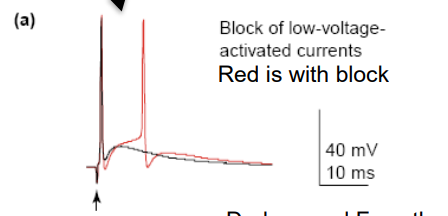
LVA K+ function
prevent hyperexcitability (by increasing the time between APs)

what happens when HVA K+ channels are blocked?
Higher peak amplitude, AP duration longer.
HVA K+ function
Keeping a shorter AP duration (to prevent hyperexcitability)
which K+ channels are particularly important or encoding information?
delayed rectifiers
what three parts of a neuron encode information?
cell bodies, axon hillock, and dendrites
how are axons involved in encoding information?
they don’t encode, but they transmit encoded information
spike rate is a function of
depolarization current
higher current → ___ firing rate
higher
Some parts of neurons encode stimulus intensity through increased ___
firing frequency (in encoders. there is not a difference in non-encoders)
where on a neuron are LVA delayed rectifiers located?
nodes/paranodes
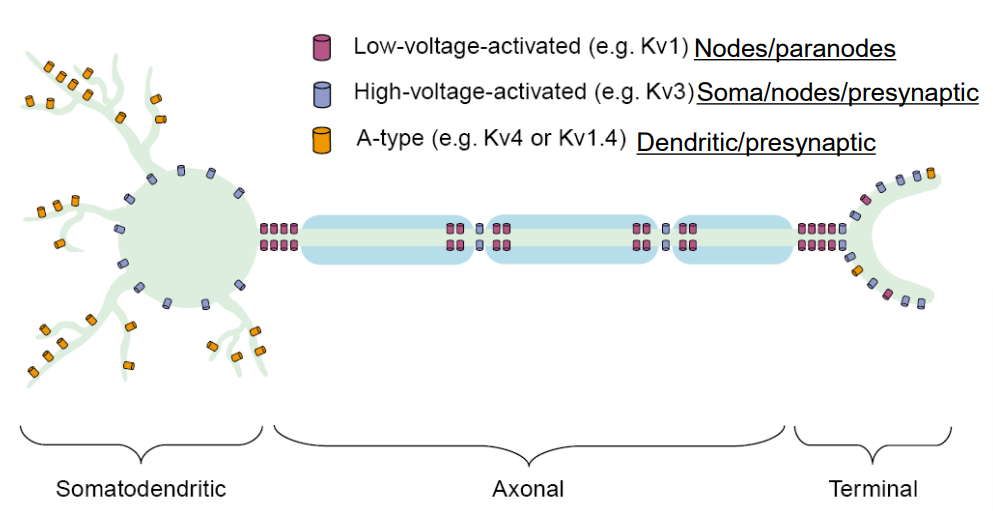
where on a neuron are HVA delayed rectifiers located?
soma/nodes/presyn terminal
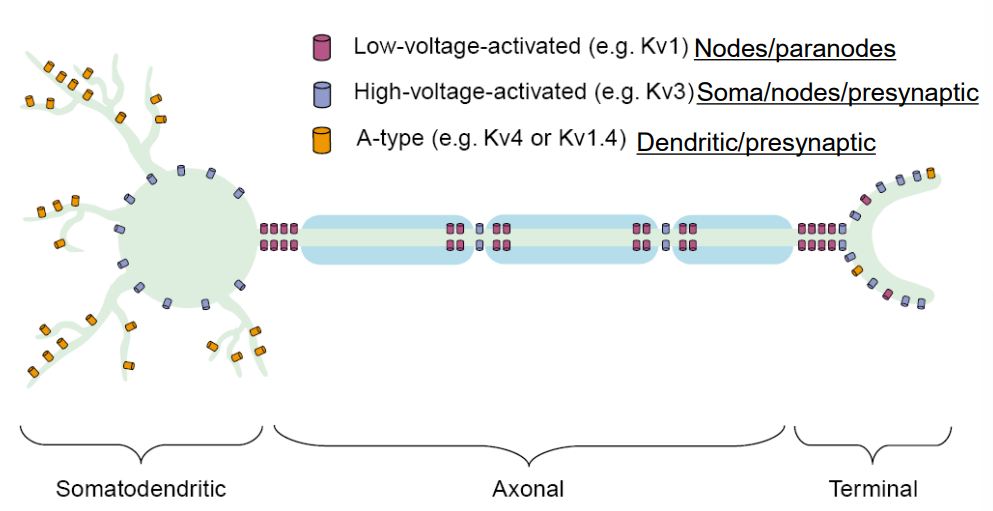
where on a neuron are A-type delayed rectifiers located?
dendritic/presynaptic terminal

which Kv channels are A type?
Kv4 and Kv1.4
A type K+ current is also called
IA or transient-outward current
A-type K+ channels are voltage ___ and ___ inactivating
voltage sensitive, fast inactivating
When are A-type K+ channels activated?
at subthreshold voltages after hyperpolarizations
A type channels function
provides a hyperpolarizing current as the cell is reaching threshold (which gives the cell more time between spikes, allowing more Na+ channels to recover from inactivation)
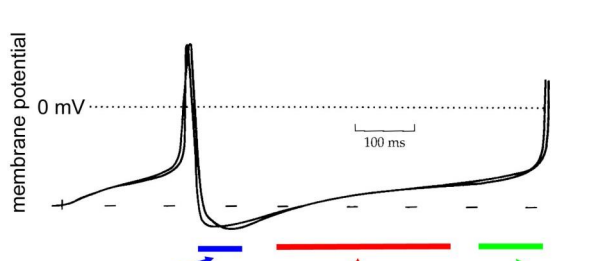
describe what is happening at each colored segment
blue - K type channels hyperpolarize the neuron after AP, allowing A-type channels to recover
red - A type channels activate, generating outward current that stops neuron depolarizing
green - A type channels slowly inactivate, so neuron depolarizes to spike threshold
what would happen if LVA type K+ channels were in the soma?
charge would leak and would not make it to the axon hillock
what is the functional significance of differential K+ expression in different regions of the neuron?
to shape APs at the nodes, to influence approach to threshold at axon initial segments, and to encode input at dendrites
Are A-type channels LVA or HVA?
LVA (Kv4)
how do you separate the LVA and HVA K+ current?
voltage clamp experiment.
First, hold at a low voltage (-80mV), then depolarize (-5mV). The current that results is the total K+ current (IK + IA)
Then, hold at a higher voltage (-40mV), then depolarize (-5mV). The current that results is the IK current, resulting from only HVAs.
Subtract the two currents to get just IA (LVA)
At resting membrane potential most KA channels are ___
inactivated
at what voltages is the probability of a Ka channel being activated zero?
below -75mV and above -40mV
KA can elongate ___
inter-spike-intervals
what are inter-spike intervals?
the time between action potentials
how do KA channels elongate inter-spike intervals?
at the end of the 1st AP, all KA channels are inactivated. Other K channels are open, resulting in hyperpolarization.
hyperpolarization removes inactivation for the KA channels and closes the K channels. to reset
This process takes time and increases the time between APs.
why is a longer inter-spike interval good?
because it gives Na+ channels more time to recover. so more are ready for the next AP.
As cell begins to depolarize the KA channels ___. K channels ___
KA channels open, slowing down depolarization
K channels act as a break
What are Shaker-type K channels
they lack the fast transient KA in the presynaptic terminal due to a mutation. This causes the presynaptic membrane to stay depolarized longer,, resulting in excess NT release
(Shaker, Shal, Shab, and Shaw): which have a rapid inactivation?
Shaker and Shal
(Shaker, Shal, Shab, and Shaw): which have a slow inactivation?
Shab and Shaw
what is N type inactivation?
a type of activation. once the activation gate opens, the N terminus plugs the pore, inactivating the channel. channel closes and the plug comes back out.
this allows for FAST inactivation
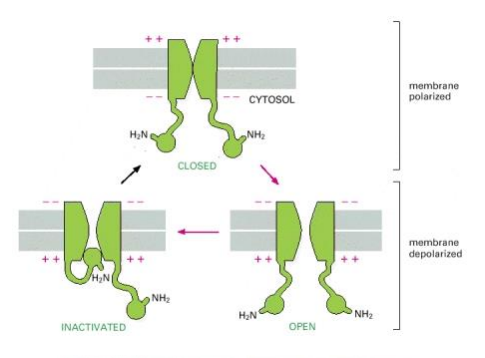
in shaker-type K channels, the N terminus can be removed, which
stops fast inactivation.
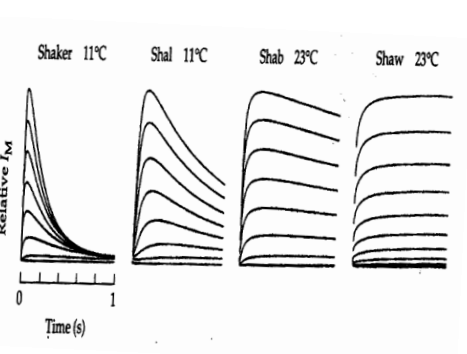
which of the following most likely has more prominent N-type activation?
the first one (shaker). it has the quickest inactivation
what are the 3 types of Ca2+ activated K+ channels?
BK, SK, and IK
how are each of the Ca2+-activated K+ channels activated?
BK - voltage and Ca+
SK - Ca2+ (Ca-CaM binding)
IK - Ca2+ only
What K channels are BK channels a type of? what are their subtypes?
BK channels are a type of Ca2+-activated K+ channel.
BK subtypes are SLO1, SLO2.1, SLO2.2, and SLO3
What K channels are SK channels a type of? what are their subtypes?
SK channels are a type of Ca2+-activated K+ channel.
SK subtypes are SK1, SK2, and SK3
compare the conductances of the different types of Ca2+ activated K channels
BK - big conductance
SK - small conductance
IK - intermediate conductance
BK and SK function
to mediate the fast and medium duration after-hyperpolarizations that occur following action potentials (contribute to spike adaptation or burst firing)
what is spike adaptation?
slowing of spiking over time
what channels contribute to spike adaptation
BK and SK
what is paxilline?
a BK blocker
what happens when paxilline is administered?
blocks BK channels. a longer AP duration, less afterhyperpolarization
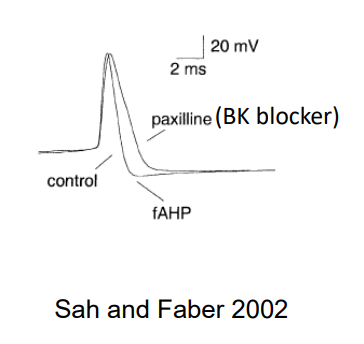
calcium activates ___, which activates SK channels
calmodulin
what channel types cooperate to produce spiking pattern?
vg-Ca2+ channels and Ca2+ activated K+ channels
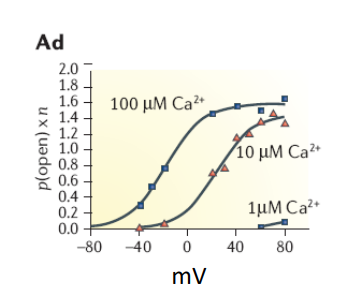
what does this graph show?
increasing calcium concentration shifts the activation curve to the left
(higher likelihood of being open at lower voltages than control)
explain how neuronal spiking pattern is produced by Ca2+ and Ca2+-activated K+ channels
(during depolarization) calcium enters neuron through vg-Ca channels during APs
high intracellular calcium activates Ca2+ dependent K+ channels, stopping cell from depolarizing
then [Ca2+] falls as Ca2+ is pumped out of cell, so K+ channels close, and neuron depolarizes to spike threshold
KCa channels are likely to be open when
there is high intracellular Ca

explain the graph
the percent of time open depends on the intracellular calcium concntration and the membrane potential.
what results in a larger motorneuron afterhyperpolarization?
multiple APs
how many AHP events are there? describe them. what are they due to?
there are two AHP events. A short and fast one and a long and slow one. both are due to potassium conductance.
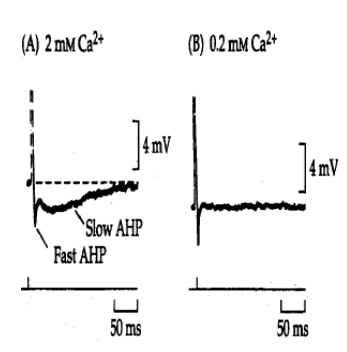
what happens to a motor neuron AHP after external Ca2+ is removed?
the long phase is blocked
how are AHPs related to spike frequency adaptation?
AHP reduces firing rate, and eventually blocks firing.
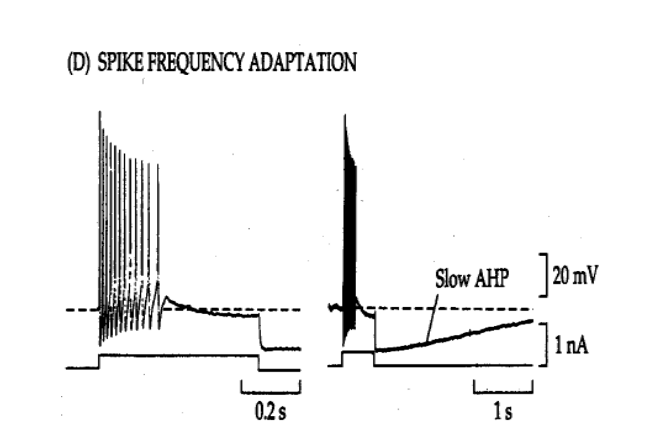
how can you prevent spike frequency adaptation in a cell?
by blocking Ca from entering the cell (can block with Cd2+)
(spike frequency adaptation is dependent on Ca2+)

what type of excitable cell is spontaneously active, highly complex with multiple channel types, and has cyclic variations of free Ca inside cell?
bursting pacemaker cells
inward rectifier channels are also called
Kir
when do inward rectifiers (Kir) stop conducting? when do they have a higher conductance?
they stop conducting during depolarization, and have a higher conductance during hyperpolarization.
Kir channels provide a (depolarizing/hyperpolarizing) influence around rest potential
hyperpolarizing
with Kir channels, the (inward/outward) current is much greater
inward
what is Ih?
hyperpolarization activated cation current. it is an inward current resulting from HCN channels
Ih current results from which ions?
Na+ and K+
what is the reversal potential of Ih?
-20mV
what is a reversal potential?
the membrane potential at which the direction of ionic current reverses (same as Nernst)
HCN channels have gating that is sensitive to
cAMP
HCN channels are activated by ___ and have a ___ depolarization. What are these channels specialized for?
hyperpolarization, slow.
HCN are thought to be pacemaker cells (found in the heart and throughout nervous system)